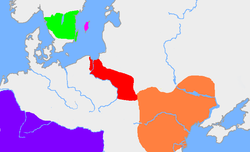
Filimer
Encyclopedia

Goths
The Goths were an East Germanic tribe of Scandinavian origin whose two branches, the Visigoths and the Ostrogoths, played an important role in the fall of the Roman Empire and the emergence of Medieval Europe....
king, according to Jordanes
Jordanes
Jordanes, also written Jordanis or Jornandes, was a 6th century Roman bureaucrat, who turned his hand to history later in life....
.
He was the son of Gadareiks and the fifth generation since Berig
Berig
Berig is a legendary king of the Goths appearing in the Getica by Jordanes. According to Jordanes, Berig led his people on three ships from Scandza to Gothiscandza...
settled with his people in Gothiscandza
Gothiscandza
According to a tale related by Jordanes, Gothiscandza was the first settlement of the Goths after their migration from Scandinavia during the first half of the 1st century CE....
. When the Gothic nation had multiplied Filimer decided to move his people to Scythia
Scythia
In antiquity, Scythian or Scyths were terms used by the Greeks to refer to certain Iranian groups of horse-riding nomadic pastoralists who dwelt on the Pontic-Caspian steppe...
where they defeated the Sarmatians
Sarmatians
The Iron Age Sarmatians were an Iranian people in Classical Antiquity, flourishing from about the 5th century BC to the 4th century AD....
. They then named their new territory Oium
Oium
Oium or Aujum was a name for an area in Scythia, where the Goths under their king Filimer settled after leaving Gothiscandza, according to the Getica by Jordanes, written around 551...
, meaning "in the waterlands". This migration would have taken place about 230 years before Jordanes wrote his "Origin of the Goths".<ref></ref>
The archaeological record shows that the population of the Gothic Wielbark culture (Poland) had indeed moved and settled in the Ukraine
Ukraine
Ukraine is a country in Eastern Europe. It has an area of 603,628 km², making it the second largest contiguous country on the European continent, after Russia...
and mixed with the previous populations of the Zarubintsy culture
Zarubintsy culture
The Zarubintsy culture was a culture that from the 3rd century BC until 1st century AD flourished in the area north of the Black Sea along the upper and middle Dnieper and Pripyat Rivers, stretching west towards the Southern Bug river. Zarubintsy sites were particularly dense between the Rivers...
, where they formed the Chernyakhov culture
Chernyakhov culture
The Sântana de Mureș–Chernyakhiv culture is the name given to an archaeological culture which flourished between the 2nd and 5th centuries in a wide area of Eastern Europe, specifically in what today constitutes Ukraine, Romania, Moldova, and parts of Belarus...
. This cultural movement is identified as the migration of the Goths
Goths
The Goths were an East Germanic tribe of Scandinavian origin whose two branches, the Visigoths and the Ostrogoths, played an important role in the fall of the Roman Empire and the emergence of Medieval Europe....
from Gothiscandza
Gothiscandza
According to a tale related by Jordanes, Gothiscandza was the first settlement of the Goths after their migration from Scandinavia during the first half of the 1st century CE....
to Oium
Oium
Oium or Aujum was a name for an area in Scythia, where the Goths under their king Filimer settled after leaving Gothiscandza, according to the Getica by Jordanes, written around 551...
, but not all scholars find the evidence compelling.<ref></ref>
Jordanes (XXIV:121) also relates that Filimer expelled the völva
Völva
A vǫlva or völva is a shamanic seeress in Norse paganism, and a recurring motif in Norse mythology....
s, who were called Aliorumnas (probably Halju-runnos, meaning "hell-runners" or "runners to the realm of the dead", which refers to their shamanistic experiences during trance). These völvas were condemned to seek refuge far away and procreated the Huns
Huns
The Huns were a group of nomadic people who, appearing from east of the Volga River, migrated into Europe c. AD 370 and established the vast Hunnic Empire there. Since de Guignes linked them with the Xiongnu, who had been northern neighbours of China 300 years prior to the emergence of the Huns,...
.
The Danish scholar Christensen has suggested that the name Filimer was made up by Cassiodorus
Cassiodorus
Flavius Magnus Aurelius Cassiodorus Senator , commonly known as Cassiodorus, was a Roman statesman and writer, serving in the administration of Theodoric the Great, king of the Ostrogoths. Senator was part of his surname, not his rank.- Life :Cassiodorus was born at Scylletium, near Catanzaro in...
,<ref></ref> a suggestion that was favourably received among historians.<ref></ref>

